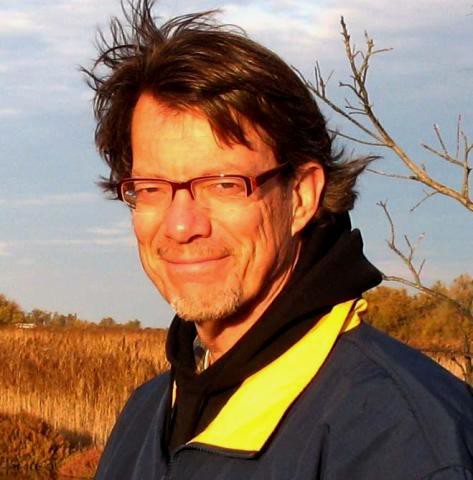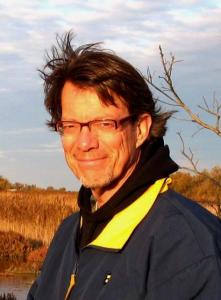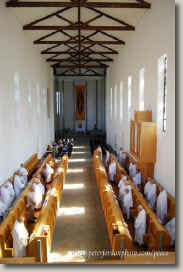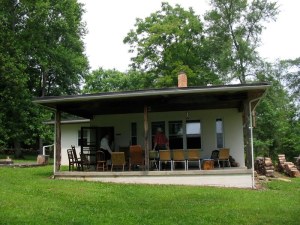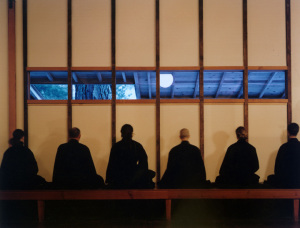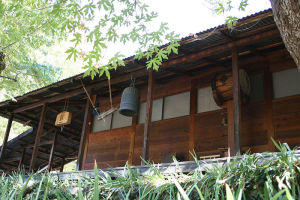Last year, my sister converted to Judaism. We grew up nominally Unitarian. The other day, I was on the phone with my friend Al, and we talked a little about why so many local Buddhists still identify as Jewish. I mentioned that it might be because there was room for both to coexist in the same person. The theme of multiple faiths keeps coming up.
One of the holiday letters we received in December came from a former Episcopal priest condemning organized religion. Given the continuous news of bombings and betrayals, I understand how he got there. But still, I was a bit surprised. With all the violence rooted in religious advocacy, it is hard to argue for religion as a basis for faith and peace. Did Jesus even intend for an organized religion to follow him? Did Buddha? I have witnessed people gain strength from faith, but where does faith begin? Does it need organized religion? A place to hold and practice it? Apparently, the architecture of the churches of Rome initially drew Thomas Merton, the Trappist monk, to Catholicism. Given the way I look at the world, perhaps the best thing that religions give us are the buildings. Nobody knows your silent prayer in a cathedral, temple, or zendo. That’s part of the beauty. You own your own moment.
Over the holidays while we were traveling, I had the chance to read Fenton Johnson’s book Keeping Faith: A Skeptic’s Journey among Christian and Buddhist Monks, published in 2003. I had sat next to the author at a San Francisco Public Library dinner in the late 1990s. I remember the date because my mother had just been placed in assisted living and I was struggling with what I thought was best for her. Often I found myself asking for guidance—I wouldn’t have thought to characterize it as prayer.
I had read one of Johnson’s novels and his memoir and enjoyed his work. I must have asked him about his next book, because we got to talking about Thomas Merton and his monastery and the local Buddhist monasteries. Merton died by accident in 1968 in Bangkok following a lecture; he never saw his gesture to the East come to fruition. Johnson spoke about growing up near Merton’s monastery, Gethsemani Abbey, in rural Kentucky, and how the monks came to his home, drank, and danced on the table. We also chatted about the San Francisco Zen Center, a different kind of religious retreat a few blocks away. At the time, I was interested in Zen Buddhism. I had sat zazen at the Berkeley Zen Center and Green Gulch. I had read about Merton but understood very little of his tradition or that of the Buddhists. I just liked my imagined aesthetic idea of them. But I was very interested that someone was going to try and write about these two monastic traditions together and perhaps fulfill some aspect of Merton’s reach.
After our dinner, I forgot to stay on the lookout for the finished work. Last fall, during one of those moments at the end of the workday when I look for old high school friends on the Internet, I thought of that chance meeting and found that Johnson had finished his book six years ago.
My passing interest in both Merton and Zen was rooted in aesthetics and frustration. For as long as I can remember, I’ve been drawn to Japanese structures and simple emotional answers to impossible questions. As a kid, I didn’t know that the Japanese tea garden in Golden Gate Park was kitschy. It felt like a calm place where my mother and I could share cups of tea and unusual snacks overlooking a little pond and forget troubles at home. I would walk around the gift shop and imagine what it would be like to live there.
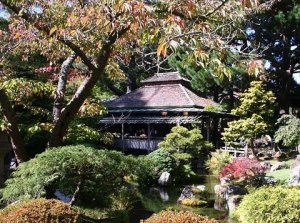
Japanese Tea Garden, Golden Gate Park
I must have first heard about Merton when I was a teenager. He looked like an authentic seeker who had some handle on truth. When I saw a photo of his concrete block hermitage many years later, I was disappointed that it wasn’t more beautifully designed. I liked my fantasy of a place to contemplate, not the reality. That was some of the baggage I brought to Johnson’s book. Maybe he could reconcile my ill-informed fantasies.
Johnson’s book begins in 1996, when there was a meeting at Gethsemani Abbey that the Dalai Lama attended. Reading the book requires work; it’s not an easy read. There are three strands: his experiences as a guest at Gethsemani and the San Francisco Zen Center monasteries; a history of monasticism, mostly Christian; and his own journey of faith. Interestingly, the two religious traditions he explores share a similar design aesthetic – at least in their sanctuaries. The chapel at Gethsemani is spare, almost Japanese, as Johnson notes. Of course, the various zendos at Green Gulch and Tassajara are informed by the temples in Japan. This was my own attraction to Buddhism, through the aesthetic door, as it were. My most memorable sitting was in a small zendo in Santa Fe where a friend took me for a two-hour meditation one evening. The structure combined the local adobe building style with Japanese traditions. You don’t begin to see what goes into adobe until you look at a piece of it for two hours. I never saw the night sky so clearly as when we emerged, as if a giant bamboo tea whisk had cleared out my head.
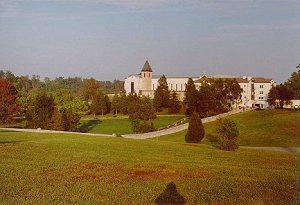
Abbey of Our Lady of Gethsemani in central Kentucky
Johnson excels at the personal narrative (this is true in his memoir, Geography of the Heart, as well). At times his well-researched history of monasticism drags a bit. But his own struggle with faith and how Buddhism and Catholicism conflict and eventually refract each other is earnest, at times stumbling, and finally illuminating. The Dalai Lama has said that there is no need for people to convert to Buddhism; they should meditate within the context of their own religion. In that way, the Dalai Lama offers a path when the original religion, in the case of Johnson and millions of other Catholics, damns you and no longer offers faith. Combined traditions can mean a way forward, and Johnson follows that path. In sitting with the Buddhists, Johnson is able to return to the core of his Christian faith. He writes about Jesus’s teachings and begins to let go of his considerable anger at the oppression coming from Rome. He favors drama, art, and the pursuit of the divine, and reminds us that each individual has to find a path that makes sense. Indeed, it is often the institution and its tendency to perpetuate itself that gets in the way.
Any journey towards faith is difficult to document. If it delves into arcane details of doctrine, it will feel academic and impersonal. But too much of the personal can feel self indulgent or solipsistic. Johnson should be recognized for his courage to reveal a deeply personal journey in a balanced and engaging way. He can be forgiven for the tedious bits – after all, he did a lot of historic research. As he tells us, faith is not the endpoint, it is a process. Although he is keenly sensitive to the environments and what they offer, his search transcends the physical reality of stone and timber. The building can shelter the searcher, even inspire a quest for faith, but it is not really faith itself.
Links
Gesthemani: www.monks.org
SF Zen Center: www.sfzc.org
Fenton Johnson’s website: www.fentonjohnson.com
Fenton Johnson’s talk on you tube
